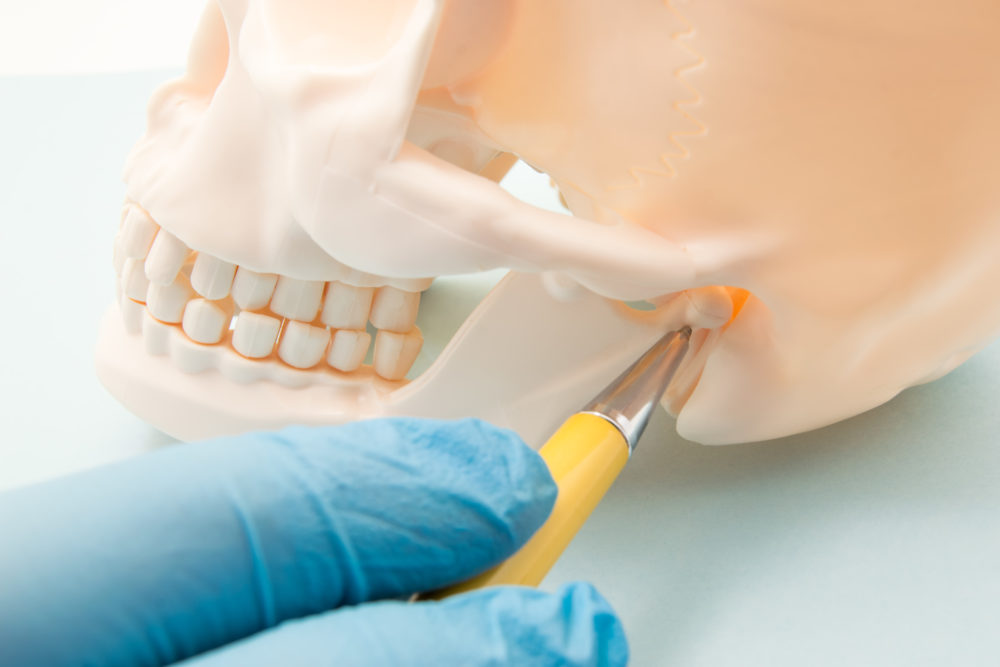
March 1, 2018
What are TMJ Disorders?
Temporomandibular Joint Disorder includes a variety of conditions that cause tenderness and pain in the temporomandibular joint (TMJ). Your TMJ is the ball-and-socket joint on each side of your head where your lower jawbone (called the mandible) joins the base of your skull at the temporal bone.
The lower jaw has rounded ends (condyles) that rotate and glide in and out of the temporomandibular joint socket when you talk, chew, or yawn. The surfaces of the condyle and the socket of the temporal bone are covered with cartilage and separated by a small articular disk, which absorbs shock and keeps the movement smooth. The muscles that enable you to open and close your mouth stabilize this joint.
Causes of TMJ Disorder
There is no one cause of TMJ Disorder, and it can be the result of one factor or a combination of several different factors. The disorder can be related to an improper bite, it can be the result of unknown genetic factors, or it can come about due to an injury or trauma from a severe blow to the jaw. Degeneration of the TMJ due to osteoarthritis, rheumatoid arthritis, or other forms of inflammation can be another cause.
Severe stress or sleep disorders can cause clenching or grinding of the teeth (a condition known as bruxism). This can tire muscles and create painful spasms, causing even more pain. Repeated muscle problems may affect the joints, resulting in tissue damage, muscle tenderness, and more spasm, perpetuating a cycle of pain.
If symptoms are not resolved within 30 days, injury to jaw joints and muscles have a greater than 50% chance of progressing to chronic or intractable pain.
Symptoms of TMJ Disorder
- jaw pain or soreness, more noticeable in the morning or afternoon
- jaw pain while chewing, biting, or yawning
- earache without an infection, sometimes spreading into the face
- a clicking or grinding noise while opening and closing your mouth
- difficulty opening and closing your mouth
- a stiff jaw when eating, talking, or yawning
- sensitive teeth without any signs of dental problems
- aching on the side of the head and neck pain
- “locking” of the jaw in an open or closed position
Diagnosing TMJ Disorder
If you have symptoms of TMJ Disorder, your dentist will first do an examination, listening to and feeling your jaw when you open and close your mouth, and observing the range of motion in your jaw. The next step is to take dental x-rays, and this may be followed by a CT scan, to provide more detailed images of bones or an MRI to examine the joint’s disk or surrounding soft tissue.
Sometimes, a TMJ arthroscopy is done, where a doctor inserts a thin tube into the joint’s area, through which a small camera is inserted to view the area and to help with a diagnosis.
Treatments for TMJ Disorder
In most cases, pain and discomfort associated with TMJ disorders can be alleviated with self-managed care or nonsurgical treatments, but more severe cases may need to be treated with dental or surgical interventions. The first thing to do is to talk to your dentist, and ask for an assessment of your TMJ.
Proper diagnosis is critical to make sure you receive treatment for your particular condition. Your dentist will recommend treatment after conducting a thorough health history, clinical exam, taking appropriate X-rays, and perhaps confirming the condition through other diagnostic tests.
Following assessment and diagnosis, your dentist will prescribe a plan for alleviating the condition, depending on the causes and degree of severity. These treatments may include:
Home self-care
- taking a pain reliever or prescription medications such as muscle relaxants, analgesics, or anti-inflammatory drugs
- eating soft foods
- avoiding chewing gum
- applying moist heat to the affected side
Behavioural changes
- relaxation techniques to control muscle tension
- stress management techniques
- breaking bad tension habits
- posture training
Physical therapy
Dental treatments
- orthopedic appliance therapy to eliminate the harmful effects of clenching or grinding the teeth, and promote a better positioning of the jaws
- occlusal equilibration (adjusting your bite), involving removing interferences when your teeth touch
- corrective dental treatment such as replacement of defective restorations that are preventing the jaws from meeting properly
- orthodontics, to put the teeth in proper position
- arthrocentesis
- surgery (for severe cases only)
In most cases, the symptoms related to TMJ Disorder can be successfully treated to reduce or eliminate your discomfort. Postponement of treatment usually results in more damage to the joint, muscles, or teeth, so if you are feeling pain or discomfort in your TMJ, speak to your dentist as early as possible.